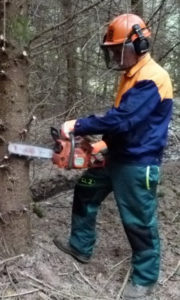Dealing with storm damage
Hopefully, your forest ‘weathered’ yesterday’s storm successfully. For those owners who have experienced windblow damage, the most important advice is not to rush into decisions but to make a step-by-step plan to minimise risk and maximise the salvage value of your plantation. Most forests, despite being blown, can have considerable timber value. The following steps will assist forest owners in planning and harvesting:
- Think safety first, a windblown forest is a dangerous place
- Contact your insurance company
- Get independent advice
- Assess the area, timber volume and likely value of the windblow
- Apply for a Felling Licence
- Consider access to the forest
- Compile a site risk assessment together with a site hazards map
- Market the windblown timber and have a strong timber sales contract in place
- Control the movement of timber, supervise and monitor the sale and harvesting operations
- Close off the sale and record keeping
- Put a replanting plan in place
Personal Protective Equipment

To protect against serious life-threatening injuries, it is very important that suitable protective clothing and equipment is worn when using a chainsaw, no matter how small the job. Modern personal protective equipment (PPE) is easy to wear, long lasting and could prevent death or serious long-term injury.
However, PPE cannot provide complete protection against cuts from chainsaws. Using chainsaws also exposes operators to high levels of noise and hand-arm vibration which can lead to hearing loss and conditions such as vibration white finger.
It is important to understand that PPE doesn’t protect you against falling trees. Chainsaw operators should refer to the manufacturer’s handbook for safety instructions and advice.
The following safety equipment should be used:
- Safety helmet, suitable eye protection or safety glasses and ear defenders
- Chainsaw gloves
- Safety boots with steel toecaps and a good grip
- Non-snag close-fitting outer clothing
- Chainsaw trousers
No personal protective equipment can ensure 100% protection against cutting by a hand-held chainsaw. A first aid kit should be readily available, including large wound dressing.
Watch the video below to find out more about essential PPE:
Chainsaw safety
If you intend to operate a chainsaw, you must ensure that:
- a risk assessment of the work to be done is carried out before commencing the work
- you are competent or alternatively have successfully completed a chainsaw training course
- you wear the Personal Protective Equipment necessary for chainsaw work activities
- any person working for you in connection with chainsaw and tree felling work activities is also competent and wearing appropriate PPE.
Don’t compromise on these essential safety requirements. Otherwise, you may be at risk of a serious accident to yourself or others.
Watch the video below for an overview of the safety features of a chainsaw.












